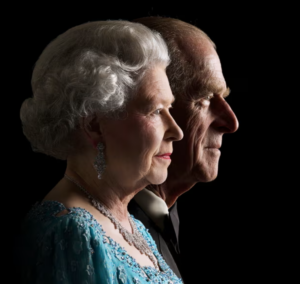Duke of Edinburgh was said to be the only person to treat the Queen as ‘simply another human being’

The one constant throughout most of Elizabeth II’s life was the Duke of Edinburgh. Prime ministers and senior courtiers came and went and each passing year stole further friends, but Prince Philip remained at her side, or a few paces behind when protocol dictated, for 73 years.
She would say that it was an outstanding working partnership and a personal triumph. She was bereft when Philip died in his sleep aged 99 in April 2021.
An “alpha” male, naturally brusque, easily exasperated and with no inclination to suffer fools, his character was in marked contrast to that of the cautious and conventional Queen.
Though deferential in public, friends attested to a more patriarchal attitude behind palace walls. In family matters she deferred to him.

One illuminating incident early in their marriage occurred when the prince was driving his wife and his uncle Lord Mountbatten to Cowdray Park polo club. Worried about their speed, she became tense and audibly drew breath until Philip barked: “If you do that once more, I shall put you out of the car.” She stopped immediately. On arrival at their destination, Mountbatten asked her: “Why didn’t you protest? You were quite right, he was going much too fast.” To which she replied: “But you heard what he said.”
Not that she was subservient. He shouted at her the way he shouted at others, and according to the biographer Sarah Bradford she was not averse to telling him: “Oh Philip. Do shut up. You don’t know what you’re talking about.”

She would take him on, unembarrassed by the presence of staff. “I am not going to come out of my cabin until he’s in a better temper,” one aide recalled her saying aboard the royal yacht Britannia.
On a state visit to Australia in 1954, a cameraman waiting outside the royal couple’s chalet to film the Queen looking at koalas and kangaroos had his camera rolling when the door was flung open and Philip came flying out, quickly followed by a pair of tennis shoes and a racket. Next came the Queen, shouting at him to come back and eventually dragging him back into the chalet.
Minutes later she reappeared, looking calm. “I’m sorry for that little interlude,” she told the cameraman. “But as you know, it happens in every marriage. Now what would you like me to do?” The cameraman exposed the film and handed it over to her press secretary.
Photographers would notice, even in the couple’s twilight years, that Philip could conjure a girlish twinkle in her eye, whether excitedly cheering him on at his carriage-driving competitions or watching him chatting to crowds on walkabout. During public engagements, she was often seen waiting for him to catch up. “Where’s Philip?” she would ask, her face lighting up as she then caught sight of him walking towards her.
Her former private secretary Lord Charteris once said: “Prince Philip is the only man in the world who treats the Queen simply as another human being. He’s the only man who can. Strange as it may seem, I believe she values that.”

She took his numerous gaffes – Philip claimed to have coined the word “dontopedalogy”, a talent for putting one’s foot in one’s mouth – in her imperturbable stride.
Commentators have devoted thousands of words to analysing the royal marriage. None came close to describing her devotion to him as succinctly as she did herself. “He is someone who doesn’t take easily to compliments,” she said in a speech to celebrate their golden wedding in 1997. “But he has, quite simply, been my strength and stay all these years, and I and his whole family, and this and many other countries, owe him a debt greater than he would ever claim, or we shall ever know.”
A distant cousin, she had met Prince Philip of Greece – his family had been exiled from the when the country became republic – on several occasions. She was 13 when she decided he would become her first crush. It was July 1939, during a royal visit to the Royal Naval College in Dartmouth where he was a cadet, and he found himself charged with entertaining Princess Elizabeth, known as Lilibet, and her nine-year-old sister, Margaret.

Marion Crawford, the princesses’ governess, later wrote of how Philip, 18, displayed a prowess for jumping over tennis nets. “I thought he showed off a good deal, but the little girls were much impressed. Lilibet said: ‘How good he is, Crawfie. How high he can jump,’” she recalled.
Biographers would later describe – Mills & Boon style – how when the royal party departed by yacht, a number of cadets set out in rowing boats to follow, all falling away until Philip alone continued far out to sea.
“Tosh,” Philip would later say. The boats followed for 200 yards, then all turned back and went home and that was that. At 18, he did not seem to share Lilibet’s romantic aspirations.

There was no thought of marriage, he said, until 1946. During the second world war, however, when as a midshipman on HMS Valiant Philip was mentioned in dispatches for his actions during the Battle of Matapan, she kept a photograph of him in her room. Their relationship developed over the following years as the homeless and peripatetic prince became an increasingly regular visitor to Buckingham Palace, Windsor and Balmoral.
The establishment thought him a little “below the salt”. George VI was dismayed his daughter wanted to marry the first man she had met and thought her too young. Queen Elizabeth, later the Queen Mother, who was never knowingly subtle, referred to him as “the Hun”, a reference to his mixed Danish, Russian and German heritage. Her brother, David Bowes-Lyon, dismissed him as “a German”.
Sir John Colville wrote of Philip’s first visit to Balmoral as a serious suitor: “Lords Salisbury, Eldon and Stanley think him no gentleman, and in a sense they are right. They also profess to see in him a Teutonic strain.” Courtiers thought him “rough, uneducated and would probably not be faithful”.
Princess Elizabeth was adamant. But in postwar Britain and with his sisters married to Nazis he would be a hard sell to the public. Practically penniless, he was nameless too unless you counted his Danish dynastic name of Schleswig-Holstein-Sonderburg-Glücksburg. His Uncle Dickie, later Lord Mountbatten, got him to the altar by generously offering up his surname, which was itself an anglicisation of the German-sounding Battenberg, and spin-doctoring his nephew to British naturalisation.

Mountbatten was still a step too far for politicians, so the Queen was persuaded to keep the equally fabricated name of Windsor for the royal family.
But, knowing how much this hurt her husband, she defied politicians after the birth of Prince Andrew and declared she was changing the rulesso that her descendants other than her children and those entitled to use HRH, would bear the surname Mountbatten-Windsor.
Throughout their marriage, Philip’s naturally flirtatious manner led to gossip about alleged affairs. Whatever the truth, and there was never any proof, the exceptional circumstances of their marriage must have required a lot of give and take in many ways.
As Philip said in his golden wedding tribute to his wife: “I think the main lesson we have learned is that tolerance is the one essential ingredient for any happy marriage. You can take it from me that the Queen has the quality of tolerance in abundance.”


